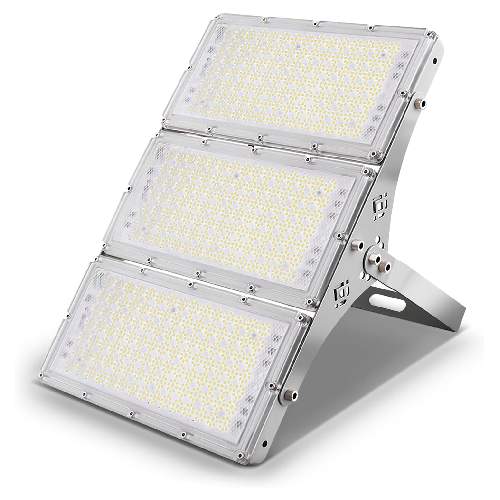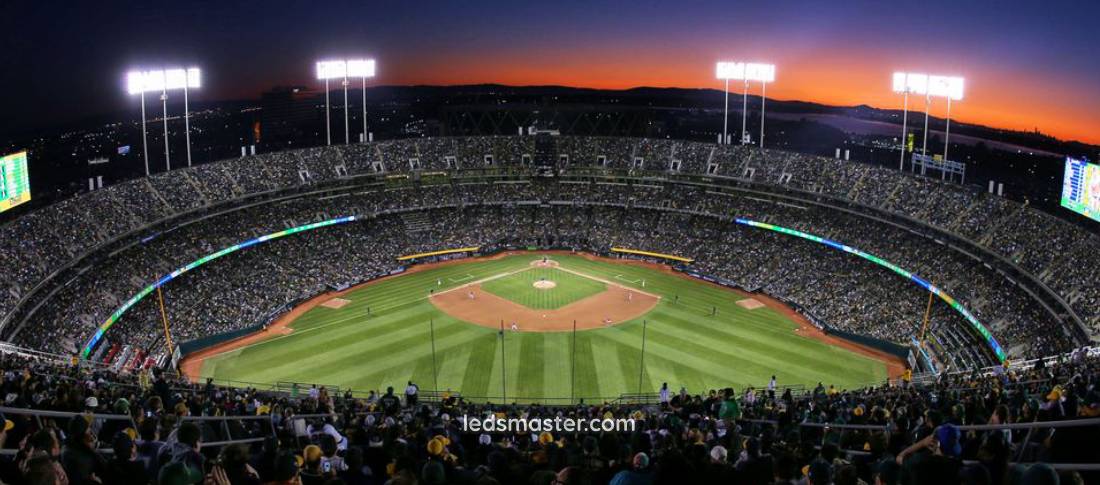
Our LED solutions, including floodlights, spotlights, and high-mast lights, offer superior illumination, energy efficiency, and durability, ensuring every game is played under the best possible conditions. Enjoy reduced operational costs and a brighter, more vibrant field with our cutting-edge lighting technology.
Get your complimentary lighting design today
Proper illumination is essential for optimal player performance, an immersive spectator experience, and enhancing the field’s aesthetics. LED lighting has transformed the illumination of baseball fields, providing significant advantages over traditional systems. This article delves into the different types of lighting fixtures used in baseball fields, the costs of installation and maintenance, lighting requirements for various occasions, the benefits of adopting LED technology, and its impact on stakeholders.
Table of Contents
ToggleBaseball field lighting primarily consists of several types of fixtures designed to meet the unique needs of the sport. The most common types include floodlights, spotlights, and high-mast lights.
Floodlights are used to provide broad, even illumination across large areas of the field. They are ideal for outfield lighting, ensuring that every corner of the field is adequately lit. Modern LED floodlights are highly efficient, offering better light quality and longer lifespans compared to traditional metal halide or high-pressure sodium lights.
Spotlights are utilized to focus light on specific areas, such as the pitcher’s mound, home plate, and bases. These fixtures provide intense, directed light that enhances visibility and ensures that critical areas are well-illuminated.
High-mast lights are tall poles equipped with multiple lighting fixtures, usually installed around the perimeter of the field. These lights are essential for providing uniform lighting across the entire field, minimizing shadows and dark spots that can affect gameplay.
The cost of installing LED lighting on a baseball field can vary significantly depending on factors such as the size of the field, the number of fixtures required, and the specific lighting requirements. On average, the initial installation of LED lights can be higher than traditional lighting systems. However, the long-term savings and benefits often outweigh the upfront costs.
LED lights have a longer lifespan, often exceeding 50,000 hours of use, reducing the frequency and cost of replacements. Additionally, they are more energy-efficient, consuming up to 70% less electricity than conventional lighting. This results in substantial savings on energy bills, making LED lighting a cost-effective solution in the long run.
Maintenance costs are also lower with LED lights. Traditional lighting systems often require frequent bulb replacements and maintenance due to their shorter lifespan and higher susceptibility to damage. LED lights, on the other hand, are more durable and require less frequent maintenance, further reducing overall costs.
| Item | Description | Price Range (USD) |
|---|---|---|
| LED Floodlights | High-efficiency lights providing broad, even illumination for outfield areas. | $1,000 – $3,000 per unit |
| LED Spotlights | Focused lights for specific areas like the pitcher’s mound and bases. | $800 – $2,500 per unit |
| High-Mast Lighting Poles | Tall poles equipped with multiple LED fixtures for uniform field lighting. | $10,000 – $30,000 per pole |
| Control Systems | Advanced lighting control systems for adjusting brightness and focusing light. | $5,000 – $15,000 per system |
| Installation Costs | Labor and materials for installing LED lighting systems. | $20,000 – $50,000 total |
| Maintenance Costs | Annual maintenance, including inspection and minor repairs. | $1,000 – $3,000 per year |
| Energy Costs | Annual electricity costs for operating LED lighting. | $5,000 – $10,000 per year |
| Replacement Bulbs | Replacement LED bulbs with long lifespans. | $100 – $300 per bulb |
The lighting requirements for baseball fields vary depending on the level of play and the specific occasion. Professional and major league baseball fields have the highest lighting standards, ensuring optimal visibility for players, spectators, and broadcast purposes. These fields typically require an average illumination level of 1500 to 2000 lux for infield areas and 1000 lux for outfield areas.
For minor league and amateur fields, the lighting requirements are slightly lower. Infield areas generally require around 1000 lux, while outfield areas need approximately 700 lux. These levels provide adequate visibility for players and spectators without the high costs associated with professional-grade lighting.
Practice fields and recreational baseball fields have the lowest lighting requirements. Infield areas need about 500 lux, and outfield areas require around 300 lux. These fields are used primarily for training and casual play, so the lighting does not need to be as intense as in competitive settings.
The adoption of LED lighting for baseball fields offers numerous benefits over traditional lighting systems. One of the most significant advantages is energy efficiency. LED lights consume significantly less electricity, which translates to lower energy bills and reduced environmental impact. This efficiency is particularly beneficial for facilities that host frequent games and events, as it helps in managing operational costs effectively.

LED lights consume significantly less electricity, which translates to lower energy bills and reduced environmental impact. This efficiency is particularly beneficial for facilities that host frequent games and events, as it helps in managing operational costs effectively.
LED lights also offer superior light quality. They provide brighter, more uniform illumination, which enhances visibility for players and improves the viewing experience for spectators. The color rendering index (CRI) of LED lights is higher, meaning that colors appear more natural and vibrant under LED lighting. This is crucial for both players, who need to see the ball clearly, and broadcasters, who aim to deliver high-quality footage to viewers.
Durability is another key benefit of LED lights. They are more resistant to shock, vibration, and extreme weather conditions, making them ideal for outdoor sports facilities. Their long lifespan reduces the need for frequent replacements, resulting in lower maintenance costs and less downtime due to lighting issues.
LED lights also offer better control and flexibility. Advanced lighting systems can be programmed to adjust brightness levels and focus light on specific areas as needed. This capability is particularly useful for different events, such as night games, practice sessions, and special occasions, allowing facilities to customize their lighting to suit the specific requirements of each event.
Players significantly benefit from the improved visibility and reduced glare that LED lighting provides. The high-quality illumination of LED fixtures ensures that the entire field is evenly lit, minimizing shadows and dark spots that can obscure the ball or distort the players’ vision. This uniform lighting is essential for enhancing players’ ability to track fast-moving objects, such as pitched baseballs or fly balls, with greater precision. As a result, players can make more accurate plays, improve their overall performance, and reduce the risk of errors caused by poor visibility. Additionally, the reduced glare from LED lights minimizes eye strain, which is crucial during extended periods of play, especially in evening games or during night-time matches. Enhanced visibility and reduced glare contribute to safer playing conditions, as players are less likely to be distracted or blinded by inconsistent lighting, allowing for a smoother and more effective game.
For spectators, LED lighting greatly enhances the overall viewing experience, both inside the stadium and through broadcast media. The high-quality illumination provided by LED lights creates a vibrant and visually appealing atmosphere that adds to the enjoyment of the game. The ability of LED lights to render colors accurately ensures that the field and the players appear true to life, making the game more engaging and enjoyable for fans. This improved color rendering also benefits television broadcasts, as the clear and consistent lighting enhances the quality of the footage, allowing viewers to experience the game with greater clarity and detail. The enhanced visibility and vibrant lighting contribute to a more immersive and captivating experience for the audience, whether they are attending the game in person or watching from home.
Facility managers and owners reap considerable operational benefits from the adoption of LED lighting. The energy efficiency of LED lights leads to substantial reductions in electricity bills, as they consume significantly less power compared to traditional lighting systems. This reduction in energy consumption not only lowers operational costs but also helps in managing budgetary constraints more effectively. Additionally, the durability and long lifespan of LED lights translate into lower maintenance costs. LED fixtures require fewer replacements and repairs, minimizing downtime and ensuring that the facility remains operational with minimal disruptions. The flexibility of LED lighting systems allows facility managers to customize and control lighting settings to accommodate various events and activities, further enhancing the versatility and utility of the facility. This adaptability increases the overall value of the venue, making it more attractive for a range of events beyond baseball games, such as concerts and community gatherings.
The environmental impact of LED lighting is a crucial consideration in today’s sustainability-focused world. LED lights are significantly more energy-efficient than traditional lighting options, leading to reduced greenhouse gas emissions and a smaller carbon footprint. By consuming less electricity, LED lights help decrease the reliance on fossil fuels and contribute to a cleaner environment. Furthermore, the long lifespan of LED lights means fewer fixtures need to be replaced over time, reducing the amount of waste generated and minimizing the number of lights that end up in landfills. Many LED lights are also designed to be recyclable, which further supports environmental sustainability by ensuring that their components can be repurposed rather than discarded. The reduced environmental impact of LED lighting aligns with broader efforts to promote green practices and supports the ongoing commitment to preserving natural resources and reducing ecological harm.
LED lighting has revolutionized baseball field illumination by offering numerous advantages over traditional systems. Types of LED fixtures, including floodlights, spotlights, and high-mast lights, ensure comprehensive coverage of the field. Although the initial installation cost may be higher, the long-term savings in energy and maintenance make LED lighting a cost-effective choice. LED lights also provide the flexibility to meet varying lighting requirements for different occasions and levels of play. The benefits of LED lighting include enhanced visibility and player performance, improved spectator experience, reduced operational costs for facility managers, and a lower environmental impact due to their energy efficiency and durability. Overall, the transition to LED lighting benefits all stakeholders, ensuring that baseball games are played and enjoyed under optimal conditions.